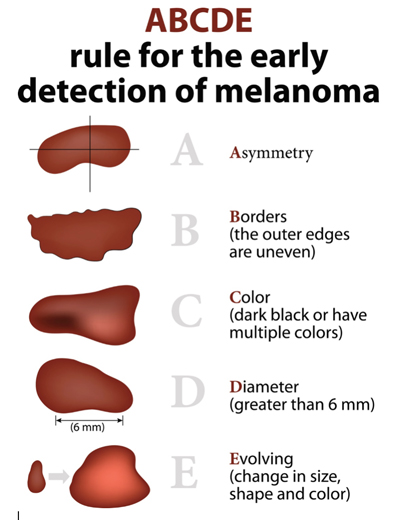
請點擊此轉換成中文
For most of us, spending time in the sun is a way to relax and lift our mood. But as we all know, too much sun can be dangerous. Learn more about skin cancer, and how you can protect yourself while still enjoying the outdoors on a beautiful sunny day.
"A healthy tan" is an oxymoron — there is simply no such thing. UV radiation from sunlight or tanning booths is officially classified as a carcinogen by the U.S. Department of Health and Human Services, just like tobacco, radon, and asbestos. Too much UV radiation damages the skin's cellular DNA and can trigger the development of skin cancer. In fact, roughly 90% of nonmelanoma skin cancers are associated with exposure to ultraviolet (UV) rays.
Skin cancer develops primarily on areas of the body that are exposed to the sun, including the face, lips, ears, neck, chest, arms, hands, and legs. It can also form on parts of the body that don't typically get a lot of sun, such as your palms, the soles of your feet, between your toes, and even under your nails.
Skin cancer affects approximately 1 in 5 people during their lifetime, making it the most common cancer in the world. In fact, more than 3.3 million people in the U.S. are diagnosed with either basal cell carcinoma (the most common type) or squamous cell carcinoma. Less common, but more dangerous, is melanoma. Understanding the different types of cancer and knowing what to look for is important for protecting your skin and getting an early diagnosis.
- Basal cell carcinoma, which usually occurs on sun-exposed areas of the body such as the face, ears, and hands, may look like a pearly or waxy bump or a flat, flesh-colored, or brown growth.
- Squamous cell carcinoma usually occurs on parts of the body that get a lot of sun and may appear as a firm, red nodule, or a flat lesion with a crusty surface.
- Melanoma is the most dangerous form of skin cancer because it grows and spreads so rapidly and can develop anywhere on the body, including hard-to-spot areas that are not exposed to the sun such as the mucous membranes of the mouth, nose, vagina, or anus.
The good news is that most skin cancer is highly treatable, including melanoma if it's caught early. That's why it's a good idea to examine your skin monthly and look for changes. The American Academy of Dermatology has simple directions for performing a skin check. You should also know "The ABCDEs of Melanoma," an easy way to remember what to look for when monitoring moles or new growths on your skin:
- A is for ASYMMETRY – the two halves of the mole don’t match in size or shape
- B is for BORDER – the edges of the mole are irregular, scalloped, jagged, or poorly defined
- C is for COLOR – the mole has two or more different colors and could include shades of tan, brown, black, white, red, or blue
- D stands for DIAMETER – Melanomas are usually larger than a pencil eraser, but they can be smaller if diagnosed early
- E stands for EVOLVING – The mole seems to be getting larger and could start to itch, bleed, burn, or change texture

Remember, do not dismiss anything that looks even slightly suspicious: Only a dermatologist can diagnose whether or not it's skin cancer!
Risk factors
Do you know your skin cancer risk? Be especially vigilant if you have one or more of these risk factors:
- Pale or light skin color (although dark skinned people can also get skin cancer)
- Skin that burns, reddens, or freckles easily, or becomes painful in the sun
- Blonde or red hair and light colored eyes
- Being over the age of 50 (although young people can and do develop all three types of skin cancer)
- A personal or family history of skin cancer
- A history of sunburns
- Regular exposure to the sun through outdoor work or leisure activities
- A large number of moles
- A history of indoor tanning
- A certain type of mole called dysplastic nevi, which are often larger than common moles and have irregular borders and pigment variations ranging from pink to dark brown
- Certain autoimmune diseases, such as lupus
- Taking medication that suppresses the immune system
Regardless of your risk level, an annual, full-body skin examination with a dermatologist is important for all adults, ideally beginning before age 30. If you have several risk factors, talk to your doctor to see if you need more frequent screenings.
Practice Sun – and Skin – Safety
Here are a few easy ways to protect yourself from damaging UV rays:
- Limit sun exposure. Try to avoid the sun between 10 a.m. and 3 p.m., when UV rays are the strongest. If you must be outdoors during those hours, seek shade whenever possible.
- Wear protective clothing, sunglasses, and a wide-brimmed hat.
- Apply sunscreen at least 20 minutes before you go out in the sun, once an hour if you are swimming or perspiring heavily.
- Make sure your sunscreen is at least SPF 50 and don't forget to cover your ears, lips, neck, feet, and backs of hands.
- Toss last year's leftover sunscreen –they lose potency after a year or two.
- Avoid sunburn. Cumulative sun damage can lead to basal and squamous cell cancers and premature aging of the skin, while melanoma is linked to intermittent sunburns.
- Avoid tanning beds.
- Perform monthly skin exams.
- Get routine full-body screenings from a dermatologist.
Don't have a dermatologist? We can help you find one here.
This article first appeared in the May 2023 edition of the HealthPerks newsletter and was updated in May 2025.

